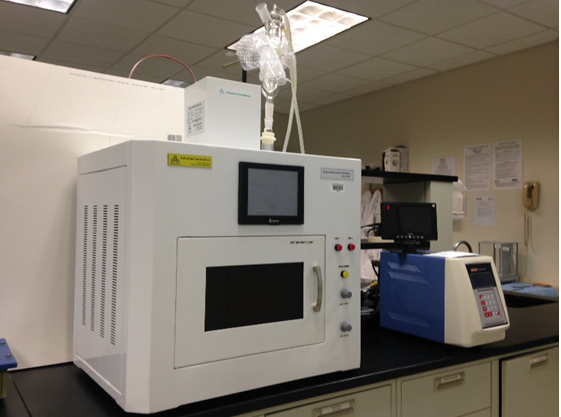- Home |
- Environmental & Instrumentation Lab
Environmental & Instrumentation Lab
Kelly Gene Cook, Sr.
Civil and Environmental Engineering
Environmental and Instrumentation Laboratory
The Kelly Gene Cook, Sr. Environmental and Instrumentation Laboratories of the Civil and Environmental Engineering Department at Mississippi State University include three separate laboratories (instrumentation, environmental and teaching laboratories) available for teaching and graduate research.
The Environmental and Instrumentation Laboratories provides high quality analyses of organic and inorganic environmental samples and contaminant to the university researchers.
In our laboratories we use accepted quality assurance and quality controls (QA/QC) parameter to comply with regulatory standards and provide the results with high accuracy and reliability.
In addition to the spacious laboratories rooms that allows to conduct multiple research at the same time, we have equipment and analytical instrumentation to manage large amount of samples.
Activities conducted in our laboratories includes: field work, sample analysis and data analysis and report. To assurance high quality research, standard operating procedures - SOP for all the activities have been developed.
The Environmental and Instrumentation Laboratories are located at Mississippi State University, Walker Hall Building, second floor, rooms 232 and 227.


Our Mission is to provide high-quality analyses to the research community at MSU. Our highlighting is on demonstrate quality in analytics, using accepted QA/QC parameters and following standard methods. Our research alignment try to develop custom and unique approaches to meet the objectives of specific research projects.
Our Policy is intended to provide safe, comfortable, and productive environment in which students and researchers can conduct work in the Environmental and Instrumentation Laboratories encountering experiences that are positive, safe, professional and educational.
About
The Kelly Gene Cook, Sr. Environmental Laboratories of the Civil and Environmental Engineering Department at Mississippi State University include three separate laboratories totaling over 3,000 sq. ft. available for graduate teaching and research. Laboratory bench space is more than adequate to meet the needs of the proposed bench and pilot-scale testing environments.
A full range of conventional environmental analyses can be performed in these facilities resulting in gross organic analysis, gross solids characterization, nutrient species determination, primary and secondary water quality evaluation, and microbial delineation. The Kelly Gene Cook, Sr. Environmental Laboratories includes a complete set of analytical instrumentation (e. g. gas chromatograph, ICP, AA/AE, UV/VIS spectrophotometers, total carbon analyzer, bioreactors and a full bioengineering laboratory component are available for physical, chemical and biological analysis of soils, sediments and water samples.
The environmental lab has developed standard operating procedures - SOP for all the activities ensuring the good quality in all the activities (field measurements, sampling procedures, treatment and analysis of samples).
Activities within research projects developed in the environmental lab include field sample treatment, sample analysis and data report and analysis.
Sample Storage
As important as the sampling and analysis process, storage plays an important role in ensuring success in a research project. The Environmental Lab at CEE has a walking in freezer with capacity to store a large amount of samples at 4°C, three freezers for storing samples with a temperature range adjustable from 0°C to 60°C and a - 20°C fixed point selector switch, and ultra-low temperature sample storage with a temperature range from- 85°C to -18°C.
Data Quality indicators
Duplicates as well as different types of samples (e. g. blanks) are used to assess precision, bias, and completeness of the data. Routine procedures for measuring precision and bias include the use of replicate analyses.
Replicate Analysis. Precision for duplicate chemical analysis is calculated as the relative percent difference-RPD.
Method of the Blank. Method blank results are assessed to determine the existence and magnitude of contamination. Field and Laboratory blanks are included in this method.
Laboratory control sample. Bias of these measurements is calculated as the ratio of the measured value to the referenced value.
Completeness. Completeness will be measured for each set of data received by dividing the number of valid (i.e., accepted) measurements actually obtained by the number of measurements that were planned.
Analytical Instrumentation
Instrumentation for physical analysis (particle size distribution, density of particle, total solids, specific gravity, Atterburg limits, water content), chemical analysis (dissolved phosphorous, total phosphorous, nitrogen, chlorophyll “a”, Blue Green algae, Rhodamine, total organic carbon, heavy metals, pH, electrical conductivity, total nitrogen, organic matter) and biological analysis is available. Equipment at the Environmental Lab is periodically revised and calibrated to ensure good results.
The Kelly Gene Cook, Sr. Environmental Laboratories include automated analytical and research facilities that incorporate an ICP speciation of metal, a TOC-V analyzer for determination of organic substances in water such us total carbon, inorganic carbon, non-purgable organic carbon and purgable organic carbon; a Trilogy Fluorometer with modules to measure fluorescence, absorbance and turbidity, for chlorophyll a, cyanobacteria, CDOM, ammonium, turbidity and dye tracers plus the determination of some chemicals/nutrients in water; a Gas Chromatography, and Bioreactors and a full bioengineering laboratory component.
The Kelly Gene Cook, Sr. Environmental Laboratories also includes basic equipment such as: pH meters, electrical conductivity meter, centrifuge with a speed range from 250 to 13,500 rpm and capacity of 4x100 mL; microcentrifuge with a maximum speed of 14,000 rpm and capacity of 18x2.0 mL, oven and muffle furnaces; and cabinets class II and chemical fume hoods.
People
Professors and technicians work together to guide student and develop projects involving field and laboratory work.
Research Scientist
Resources
The following information has been developed for the Environmental and Instrumentation Laboratory:
The following information could be really useful when working in the lab. The information was developed by the Environmental Health & Safety at MSU:
Valuable information available at the Environmental Health & Safety webpage http://ehs.msstate.edu/





